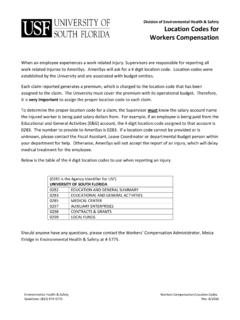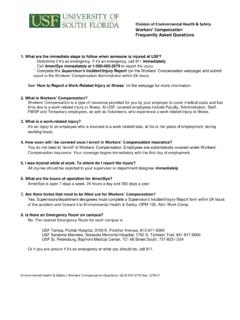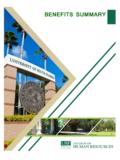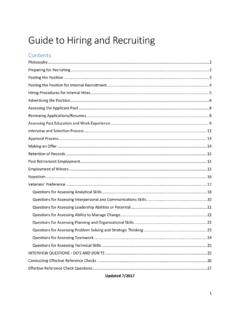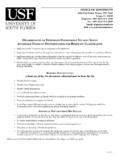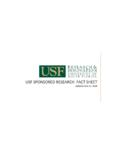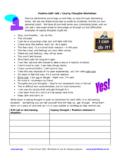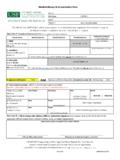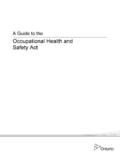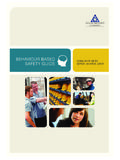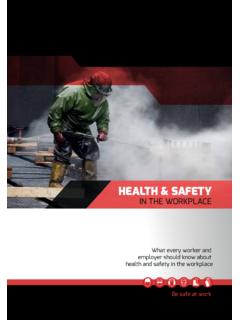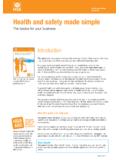Transcription of Studio & Shop Safety Guide - usf.edu
1 Environmental Health & Safety 4202 E. Fowler Ave. OPM 100 Tampa, FL 33620 (813) 974-4036 May 2020 Shop Safety THIS PAGE INTENTIONALLY LEFT BLANK Contacts and Objectives Working in academic shops carries risk of exposure and injury due to hazardous materials and machines. Shop equipment and processes can cause physical injury, illness, or cause fires if not properly used. It is essential for everyone working in a shop to understand shop hazards and how to protect themselves and those working around them. Training Objectives To provide Safety guidelines for workers and researchers in academic shops and studios To increase awareness of environmental compliance regulations To provide Safety -related contact information and resources for shops and studios Individual Responsibilities The key to having a safe shop/ Studio environment lies with an individual's commitment to Safety .
2 The USF Chemical Hygiene Plan outlines the responsibilities of individuals working in chemical laboratories , which includes shops/studios. All individuals are required to: Follow all University Safety procedures and shop-specific Standard Operating Procedures (SOPs) as outlined by the Chemical Hygiene Plan, EH&S, and the Principal Investigator/supervisor Attend all required Safety trainings Report any conditions deemed unsafe to the Principal Investigator, Lab Supervisor, or EH&S Supervisor Responsibilities The USF Chemical Hygiene Plan also outlines the responsibilities of Principal Investigators/Supervisors working in chemical laboratories. All supervisors are required to: Write job-specific Safety and compliance procedures and make them available to everyone Ensure all tools/equipment are in good working order and regularly maintained Provide required Safety equipment to staff Ensure that everyone receives appropriate Safety training and it is documented Ensure that everyone follows Safety and compliance procedures Ensure correction of identified hazards Report all injuries/illnesses to Environmental Health & SafetyWeb: Mail: OPM 100 Phone: 813-974-4036 Waste Management Occupational Safety Industrial Hygiene Lab Safety Asbestos/Indoor Air Quality Insurance/Risk Management Fire Safety Building Code Administration Contents Machine and Tool Safety .
3 4 Table 1: Common Shop Machines .. 5 Chemical Safety : Hazard Classes .. 7 Chemical Safety : Storage .. 7 Minimizing Hazards: Exposure and 8 Minimizing Hazards: Personal Protective Equipment & Engineering Controls 8 Emergency Response: Spills .. 9 Emergency Response: Accidents .. 10 Emergency Response: Fire .. 10 Fire Code Violations .. 11 Emergency Response: Incident Reporting .. 11 Hazardous Waste .. 11 Universal Waste .. 11 Chemical Waste .. 12 Metal Waste .. 12 References .. 13 Appendix 1: Studio and Shop Safety Checklist .. 14 4 Machine and Tool Safety Complete training with an experienced user. Do not use any machine or tool unless you have been trained and are familiar with its use. Read and follow the Standard Operating Procedure (SOP). See Appendix 1 for a template. Use the appropriate machine or tool for the job. Wear Personal Protective Equipment (PPE) appropriate for the machine or tool.
4 Perform a start-up check before beginning work: o Is the machine well-maintained and in good working order? o Is the work area and floor clean and free of slip/trip hazards? o Are machine guards in place on machines with moving parts? o Are blades at the appropriate height, unbroken, sharp, and secure? o Are clamps in position and secure? o Are bits secure? o Have chuck keys been removed? o Do you know where the ON/OFF switch is? Do not use any machine or tool if you are overly tired, sick, or otherwise impaired. Do not work alone. Be aware of the hazards of electricity: o Working with electricity presents special hazards related to shock and fire. o Do not run wires where they may be damaged. o To avoid shock, remove metal rings, bracelets, and watches from hands. o Make sure hands, tools, equipment, and floor are dry. o Inspect equipment before use and report frayed wires and bent or missing prongs on plugs.
5 O Turn off and unplug equipment before performing maintenance on it. o Know the location of the emergency power off, or shunt, which is usually a large red button. o EH&S Lockout/Tag Out Training is required for anyone servicing or maintaining machines or equipment in which the unexpected energizing or startup of the machines or equipment or the release of stored energy could cause injury to Table 1: Common Shop Machines Tool/Machine Description PPE Before Use Tips During Use Band Saw A continuous metal blade with teeth on one edge. Used with wood, metal, and other materials Safety glasses. Face shield if material is likely to chip. NO gloves or long sleeves. Secure saw to floor or bench. Guard should cover entire blade except for working part. Table should be clean. Blade should be tight. Use a push stick. Bench Grinder A machine that spins abrasive wheels. Used to sharpen or clean metal parts.
6 Face shield, ear protection, leather gloves, and a leather apron. Tongue guards, side guards, and eye guards must be in place. Stand off to the side when starting. Do not grind on the side of the wheel. Dip metal in water to cool. Drill Press A type of drill where the chuck and spindle are moved vertically using a set of handles in the head. Used with wood, metal, or other materials. Safety glasses. Face shields are recommended. Clamp work. Use appropriate drill bit and speed setting. Secure bit and remove chuck key. For deep holes, raise bit periodically to clear cuttings and cool bit. Free a bound drill by first turning off power, then turn chuck backwards by hand. Lathe A wood or metalworking machine that shapes materials by rotating the work against a cutting tool. Safety glasses and hearing protection. NO gloves or long sleeves. Clamp work. Remove the chuck key before starting machine.
7 Do not reach over the spinning chuck. Milling Machines A versatile family of machine that uses rotary cutting action to precisely shape parts. Safety glasses with side shields or goggles and hearing protection. Clamp work. Make sure spindle is free to rotate. Power off to change cutters and remove tightening wrench after use. Stay at the machine. Take light cuts and feed slowly. Router Table A table with a hole through which the bit of a tool protrudes. Used to hollow out space in wood or plastic. Safety glasses and hearing protection. Cutter should be sharp, clean, and clear to rotate. Feed work slowly. Use jigs, fixtures, and templates when possible. Table Saw A circular saw blade that protrudes through a table supporting the stock being cut. Used with wood. Safety glasses, goggles, or face shields. NO gloves or long sleeves. Guards, anti-kick back devices, and spreaders must be in place.
8 Blades should be clean and sharp, and height should be no more than above stock. Use push sticks on stock less than six inches wide-do not use a metal push stick. Disconnect power before changing blade. Do not reach behind or over a spinning blade. Stand to the side of the blade, not directly in line with it. 6 Chemical Safety : Resources 1.) Manufacturer s Label The manufacturer of a chemical must provide a label that indicates: Full name of chemical Hazard warnings Name and address of manufacturer * Chemical containers without manufacturer s labels should be returned to the manufacturer. 2.) Safety Data Sheets (SDS) An SDS (formerly called MSDS) is a document, prepared by the manufacturer, which contains Safety information for materials containing hazardous chemicals. It tells about: Material components Dangers Safe handling of material An SDS is shipped with each chemical but can also be found online.
9 Be sure that you have immediate access to the SDS for chemicals you are working with. 3.) NFPA Label This label was developed by the National Fire Protection Association to identify and rank a material s hazards. Hazards are rated from 0 (no hazard) to 4 (extremely hazardous). Fire Hazard labeled in red Health Hazard labeled in blue Reactivity Hazard labeled in yellow Specific Hazard labeled in white (OX=oxidizer, W=use no water, CORR=corrosive, ALK=alkali) 7 4. GHS Classification The Globally Harmonized System of Classification and Labeling of Chemicals (GHS), is a universal approach to defining chemical hazards, criteria to compare these hazards, and hazard communication. Hazardous chemical labels and SDSs will present information in alignment with the GHS. It is important to remember that, within the GHS, hazards are rated from 1 (extremely hazardous) to 4 (no hazard), which is the opposite of the NFPA system.
10 Chemical Safety : Hazard Classes FLAMMABLE A material that may catch fire and burn in air Any liquid having a flashpoint below 100 degrees F ( degrees C). Flammable vapors are usually heavier than air (vapor density > 1), so it is possible for the vapors to travel along floors and, if an ignition source is present, result in a flashback fire. Store flammable liquids only in specially designed flammable storage cabinets and refrigerators/freezers or explosion-proof refrigerators/freezers away from ignition sources and oxidizers. OXIDIZER/REACTIVE An unstable material that may ignite, explode, or produce toxic gas under certain conditions Examples include sodium, t-butyl lithium, aluminum nitrate, perchloric acid, nitric acid, and sodium peroxide. Store away from flammable materials and place in a secondary containment when stored with incompatible materials. CORROSIVE A material that destroys metal and can cause destruction of tissue upon exposure Has a pH of less than 2 or greater than Examples include strong acids such as hydrochloric acid and sulfuric acid, and strong bases such as potassium hydroxide and sodium hydroxide.
